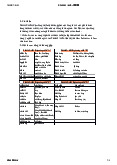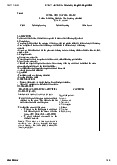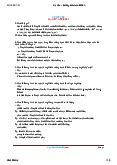





Preview text:
The Step Pyramid Of Djoser IELTS Reading Answers with Explanation
Luyện tập đê IELTS Reading Practice với passage The Step Pyramid Of Djoser được
lấy từ cuốn sach IELTS Cambridge IELTS Practice Test 16 - Test 1 - Passage 2 với
trải nghiệm thi IELTS trên máy và giải thích đáp án chi tiết bằng Linearthinking, kèm
list từ vựng IELTS cần học trong bài đọc.
DOL IELTS Đình Lực 28/02/2022
https://tuhocielts.dolenglish.vn/ielts-reading-practice-luyen-tap-ielts-reading-the-step-pyramid-of-djoser-cambridge-ielts-16 Làm Bài
https://tuhocielts.dolenglish.vn/ielts-reading-practice-answer-key-the-step-pyramid-of-djoser-cambridge-ielts-16 -test-1 -pa Xem giải thích
https://tuhocielts.dolenglish.vn/ielts-reading-practice-tu-vung-the-step-pyramid-of-djoser-vocab-cambridge-ielts-16 -test-1 Từ vựng Bài đọc (reading passage) The Step Pyramid of Djoser
A. The pyramids are the most famous monuments of ancient Egypt and still hold enormous interest for
people in the present day. These grand, impressive tributes to the memory of the Egyptian kings have
become linked with the country even though other cultures, such as the Chinese and Mayan, also built
pyramids. The evolution of the pyramid form has been written and argued about for centuries. However,
there is no question that, as far as Egypt is concerned, it began with one monument to one king designed
by one brilliant architect: the Step Pyramid of Djoser at Saqqara.
B. Djoser was the first king of the Third Dynasty of Egypt and the first to build in stone. Prior to Djoser's
reign, tombs were rectangular monuments made of dried clay brick, which covered underground passages
where the deceased person was buried. For reasons which remain unclear, Djoser's main official, whose
name was Imhotep, conceived of building a taller, more impressive tomb for his king by stacking stone
slabs on top of one another, progressively making them smaller, to form the shape now known as the Step
Pyramid. Djoser is thought to have reigned for 19 years, but some historians and scholars attribute a
much longer time for his rule, owing to the number and size of the monuments he built.
C. The Step Pyramid has been thoroughly examined and investigated over the last century, and it is now
known that the building process went through many different stages. Historian Marc Van de Mieroop
comments on this, writing ‘Much experimentation was involved, which is especially clear in the
construction of the pyramid in the center of the complex. It had several plans... before it became the first
Step Pyramid in history, piling six levels on top of one another... The weight of the enormous mass was a
challenge for the builders, who placed the stones at an inward incline in order to prevent the monument breaking up.
D. When finally completed, the Step Pyramid rose 62 meters high and was the tallest structure of its
time. The complex in which it was built was the size of a city in ancient Egypt and included a temple,
courtyards, shrines, and living quarters for the priests. It covered a region of 16 hectares and was
surrounded by a wall 10.5 meters high. The wall had 13 false doors cut into it with only one true entrance
cut into the south-east corner; the entire wall was then ringed by a trench 750 meters long and 40 meters
wide. The false doors and the trench were incorporated into the complex to discourage unwanted visitors.
If someone wished to enter, he or she would have needed to know in advance how to find the location of
the true opening in the wall. Djoser was so proud of his accomplishment that he broke the tradition of
having only his own name on the monument and had Imhotep's name carved on it as well.
E. The burial chamber of the tomb, where the king's body was laid to rest, was dug beneath the base of
the pyramid, surrounded by a vast maze of long tunnels that had rooms off them to discourage robbers.
One of the most mysterious discoveries found inside the pyramid was a large number of stone vessels.
Over 40,000 of these vessels, of various forms and shapes, were discovered in storerooms off the
pyramid's underground passages. They are inscribed with the names of rulers from the First and Second
Dynasties of Egypt and made from different kinds of stone. There is no agreement among scholars and
archaeologists on why the vessels were placed in the tomb of Djoser or what they were supposed to
represent. The archaeologist Jean-Philippe Lauer, who excavated most of the pyramid and complex,
believes they were originally stored and then given a 'proper burial' by Djoser in his pyramid to honor his
predecessors. There are other historians, however, who claim the vessels were dumped into the shafts as
yet another attempt to prevent grave robbers from getting to the king's burial chamber.
F. Unfortunately, all of the precautions and intricate design of the underground network did not prevent
ancient robbers from finding a way in. Djoser's grave goods, and even his body, were stolen at some point
in the past and all archaeologists found were a small number of his valuables overlooked by the thieves.
There was enough left throughout the pyramid and its complex, however, to astonish and amaze the
archaeologists who excavated it.
G. Egyptologist Miroslav Verner writes, 'Few monuments hold a place in human history as significant as
that of the Step Pyramid in Saqqara ... It can be said without exaggeration that this pyramid complex
constitutes a milestone in the evolution of monumental stone architecture in Egypt and in the world as a
whole.' The Step Pyramid was a revolutionary advance in architecture and became the archetype which all
the other great pyramid builders of Egypt would follow. Câu hỏi (questions ) Question 1 - 7
The Reading Passage has seven paragraphs, A-G.
Choose the correct heading for each paragraph from the list of headings below. Write the correct number, i-ix List of Headings I
The areas and artefacts within the pyramid itself II
A difficult task for those involved III A king who saved his people IV
A single certainty among other less definite facts V
An overview of the external buildings and areas VI
A pyramid design that others copied
VII An idea for changing the design of burial structures
VIII An incredible experience despite the few remains IX
The answers to some unexpected questions 1 Paragraph A 2 Paragraph B 3 Paragraph C 4 Paragraph D 5 Paragraph E 6 Paragraph F 7 Paragraph G Question 8 - 11 Complete the notes below.
Choose ONE WORD ONLY from the passage for each answer. The Step Pyramid of Djoser
The complex that includes the Step Pyramid and its surroundings is considered to be as big as an Egyptian 8
of the past. The area outside the pyramid included accommodation that was occupied by 9
, along with many other buildings and features.
A wall ran around the outside of the complex and a number of false entrances were built into this. In addition, a long 10
encircled the wall. As a result, any visitors who had not been invited
were cleverly prevented from entering the pyramid grounds unless they knew the 11 of the real entrance. Question 12 - 13 Choose TWO letters, A-E.
Which TWO of the following points does the writer make about King Djoser? A
Initially he had to be persuaded to build in stone rather than clay. B
There is disagreement concerning the length of his reign. C
He failed to appreciate Imhotep's part in the design of the Step Pyramid. D
A few of his possessions were still in his tomb when archaeologists found it. E
He criticised the design and construction of other pyramids in Egypt.
Answer key (đáp án và giải thích) 1 IV htt Xeps m :/ f /t ulluhoci giải e t l h tís c .d h olengl 2 VII htt Xeps m :/ f /t ulluhoci giải e t l h tís c .d h olengl 3 II htt Xeps m :/ f /t ulluhoci giải e t l h tís c .d h olengl 4 V htt Xeps m :/ f /t ulluhoci giải e t l h tís c .d h olengl 5 I htt Xeps m :/ f /t ulluhoci giải e t l h tís c .d h olengl 6 VIII htt Xeps m :/ f /t ulluhoci giải e t l h tís c .d h olengl 7 VI htt Xeps m :/ f /t ulluhoci giải e t l h tís c .d h olengl 8 city htt Xeps m :/ f /t ulluhoci giải e t l h tís c .d h olengl 9 priests htt Xeps m :/ f /t ulluhoci giải e t l h tís c .d h olengl 10 trench htt Xeps m :/ f /t ulluhoci giải e t l h tís c .d h olengl 11 location htt Xeps m :/ f /t ulluhoci giải e t l h tís c .d h olengl 12 B htt Xeps m :/ f /t ulluhoci giải e t l h tís c .d h olengl 13 D htt Xeps m :/ f /t ulluhoci giải e t l h tís c .d h olengl
Hãy cùng DOL khám phá kho đề thi IELTS Reading Practice với lời giải thích chi tiết ở đây -> ye




